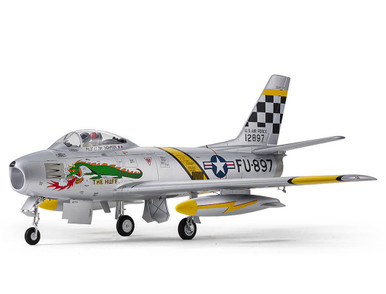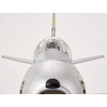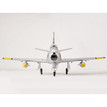 Loading... Please wait...
Loading... Please wait...- 07 38233033
- Home
- My Account
- Gift Certificates
- View Cart
- Home
- Radio Controlled
- Aircraft ,Helis
- Edf
- FMS 80MM F-86 THE HUFF PNP SILVER
FMS 80MM F-86 THE HUFF PNP SILVER
Product Description
FMS 80MM F-86 THE HUFF PNP SILVER
After the end of World War II, the United States and the Soviet Union brought back aviation experts, data, and equipment from Germany to create their own jet fighter aircraft. The F-86 fighter jet, nicknamed "Sabre," was a swept-wing jet fighter developed by the United States. It was the first-generation jet fighter in service with the U.S. Air Force, capable of air-to-air combat, aerial interception, and bombing missions. It was also the world's first fighter aircraft equipped with air-to-air missiles and the first U.S. fighter aircraft with an ejection seat.
Building upon their extensive experience in developing remote-controlled model fighter aircraft, FMS has made significant efforts to faithfully replicate the legendary and classic F-86 "Sabre" with the product standard of "perfect appearance, excellent performance." The model is filled with numerous realistic details, such as operable landing-gear doors, retractable CNC-machined landing gear, movable airbrakes, wing navigation lights (red on the left, green on the right), jet nozzle navigation lights (one red, one white), and landing lights (white). The static model-level exterior details have also been meticulously addressed, including fuel tanks, cockpit interior (molded plastic parts), and antennas. It's worth mentioning that the interior plastic parts of the cockpit and the airbrakes have both undergone an antiquing process, creating a bridge to the past.
Eight 13g all-metal digital servos control the ailerons, flaps, rudder, and elevator, precisely executing input commands to simulate the maneuverability of a fighter aircraft, making maneuvers such as pitching, rolling, yawing, and flipping, easily achievable. Three 9g semi-metal servos control the airbrakes, which can increase the drag and reduce the speed of the aircraft, and the operating of the front-landing gear door, which when worked with the sequencer, can simulate the delayed opening and closing of the front-landing gear door, ensuring synchronization with the movement of the landing gear during the deployment or retraction process, ensuring safety and smoothness.
The PNP configuration includes a 12-blade 80mm ducted fan, a high-power 3665-KV2000 brushless inrunner motor, and a 100A ESC (with a 5A switch-mode BEC), designed to be used with a commonly available 6S 4000-5500mAh LiPo battery (to be purchased separately). This high-performance power and control system provides excellent performance, longer flight times, and a more realistic turbine-like engine sound for "combat" flying.
Additionally, key areas of the "Sabre" model, such as the fuselage, wings, and tail, are reinforced with multiple embedded strengthening tubes and reinforcement plates, ensuring structural strength during extreme flight maneuvers. The two-piece design of the fuselage reduces packaging size by thirty percent, facilitating easy transport and storage. The model is available in two classic schemes, "THE HUFF" and "SKYBLAZERS," which are easily recognizable in clear skies or overcast conditions.
FEATURES
- Electronic configuration: 80mm 12-blade ducted fan, 3665-KV2000 brushless motor, high-performance 100A ESC, 8x 13g all-metal digital servos, 3x 9g semi-metal servos.
- Rich in dynamic and static realistic details, such as operable landing-gear doors, retractable CNC-machined landing gear set, movable airbrakes, navigation lights, landing lights, fuel tanks, scaled cockpit interior, etc.
- Antiqued cockpit interior and airbrakes.
- CNC-machined shock-absorbed full-metal landing gear set effectively countering hard landings.
- Pressing buckle design latch keeps intact surface and prevents unexpected canopy release in flight.
- Two-piece fuselage structure reducing packaging size by thirty percent.
- Realistic water-based paint finish, offering a high-quality appearance.
SPECIFICATIONS
Wingspan: 1220mm /48 in
Overall Length: 1165mm/46in
Flying Weight: Around 3050g
Motor Size: 3665 KV2000
ESC: 100A
Servo: 13g x 8pcs
Servo: 9g x 3pcs
Radio: 6 Channel
CG (center of gravity): 180-190mm
Prop Size: 80 x 12
Recommended Battery: 22.2V 4000mAh-5000mAh 45c
Aileron: Yes
Rudder: Yes
Flaps: Yes
Retracts: Yes
Approx. Flying Duration: 3 minutes
Minimum Age Recommendation: 14+
Assembly Time: 10minutes
Wing Load: 95.3g/dm² (0.18oz/in²)
Wing Area: 32dm² (495.8 sq.in)














